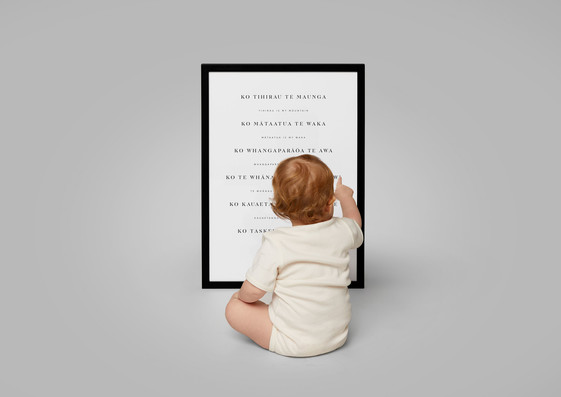To lift our days during this time, each week the Designers Institute will release a case study on a Best Design Awards 2019 Purple Pin winner
– a project description in the words of the designers along with a short interview with writer Mike Barrett.
Purple Pin Case Study — Ngā Aho
Designworks
Pepehā
Ngā Aho Award: Pepeha
Studio: Designworks
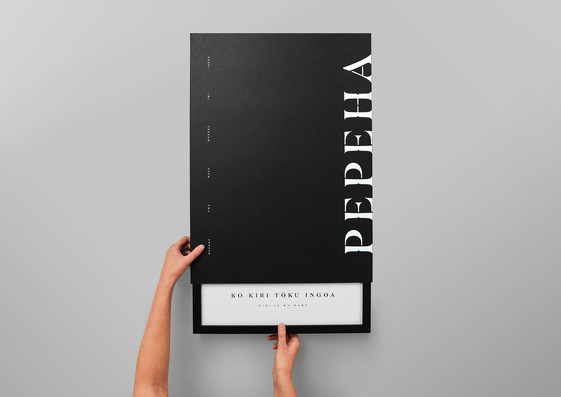
Act to preserve, protect and revitalise Te Reo Māori
Project description
It’s the land that shapes our community; our community that shapes our whānau; and our whānau that shapes us as individuals.
Koinei tā Aotearoa whakamihi. This is Pepehā, and this is how New Zealand introduces itself.
Around the world, indigenous languages are in decline – and with them, tradition, culture and identity. Since the early days of European colonisation of New Zealand, Te Reo Māori has been supressed and marginalised. But in recent years, there has been an awakening, a realisation that we must actively preserve, protect and revitalise Te Reo Māori.
We knew that design had a part to play in this revitalisation, so we created Pepehā. A collaboration between Designworks, 3 Degrees Consultancy, and Te Ara Poutama AUT. Pepehā is a not-for-profit initiative that enables all New Zealanders to learn, create and share their own pepehā, a traditional form of Māori introduction.
To enable this, an intuitive digital platform was created to encourage people to learn about and understand their backgrounds. While every pepehā is different, typography was used as the vehicle to stitch together the myriad identities of Aotearoa. The bespoke typeface echoes forms of place, enriching the connection to the meaning of every word.
Since its launch, the Pepehā website has had more than 109,000 unique visitors, an average session duration of 4 minutes 5 seconds, and over 48,000 downloads. It has been adopted and implemented in hundreds of schools: Kōhanga Reo, Kura Kaupapa Māori, daycare, primary schools, secondary schools, universities and other tertiary institutes, as well as in many businesses. Pepehā have been hung in homes, saved as screensavers, shared as gifts, and incorporated into some of New Zealand’s most iconic organisations, such as Tourism New Zealand.
Today, it continues to grow and gain momentum. Most importantly, it provides a new gateway for hundreds of thousands of New Zealanders to learn more about Te Reo and Te Ao Māori. Pepehā: a taonga to New Zealand.
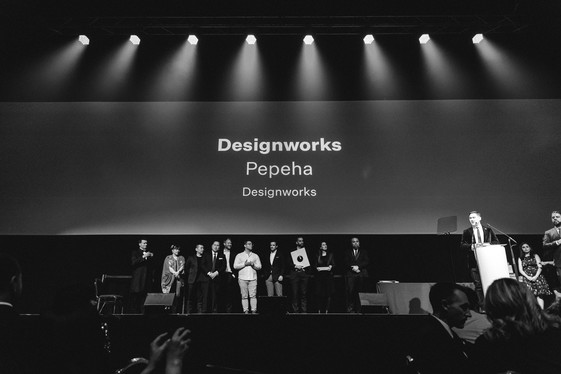
Q&A
Mike Barrett talks to Anzac Tasker PDINZ, Creative Director and Jef Wong FDINZ, Executive Design Director at Designworks.
So, pepehā – first off, congratulations, what a really great idea, when did it come to you?
Anzac: Thank you. The idea formed when I started doing my course in te reo Māori, and of course developing a pepehā is an early part of that. Pepehā are personal – it’s about the individual and for the individual it’s a kind of gateway to understanding Māoridom through personal identity and the building up of identity through places of belonging. When I was doing the course, I saw everybody writing their pepehā on post-it notes and putting them in their pockets. Or writing it in a book and just closing it and putting it away, so I thought there was a way we could elevate that experience.
I think the most beautiful thing about the pepehā is that it’s identifying yourself through the environment that you were raised in. It’s a belief in Māoridom that you’re a reflection of your environment. You are an extension of your environment, your community, and your family. So, those are the layers of the pepehā. It starts with the mountains, the rivers, the lakes, and then in comes into the iwi, your community, and hapū, your more immediate family. Then your whānau, the people that raised you. The most insignificant part of your identity is yourself. It’s a really lovely way to convey Māoridom’s environmental centricity.
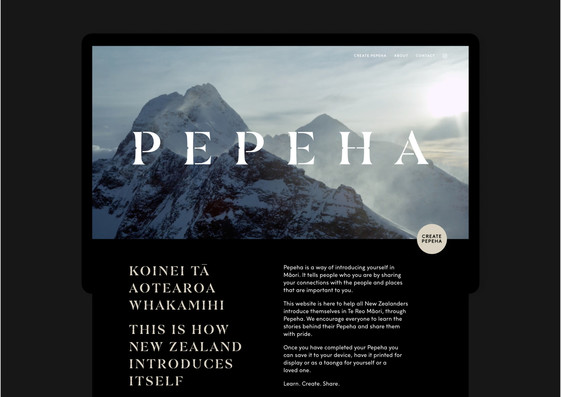
It’s interesting isn’t it, that this authentic kind of storytelling is right there in front of us. Quite removed from the stories we tell when we’re locating commercial entities in the New Zealand story.
Jef: You know, we’re always talking about telling New Zealand stories, but often it’s through a commercial lens. We’ve actually been telling New Zealand stories for forty years which – and that has been really great – but this way of understanding and embracing the Māori story telling has been a particularly interesting journey for us as a studio, and for Anzac, as he’s taken on the challenge of full immersion. So, when Anzac does his pepehā, I go, oh, I know people on Waiheke. You immediately break down barriers by doing a pepehā because, you know, it’s like you’re from Mt Albert, and we go, oh, yeah, my kids go to school there – there’s an instant accessibility and connection to people, as well as the ability to educate yourself around Māori culture. It was a lovely thing all around.
Past projects, acknowledged with Best Awards were also forged from close ties with cultural taonga and language. This seems to fit well into that canon of work.
Anzac: I think for us this added to the revitalisation and the lifting of the mana of te reo Maori that we’ve been invested in for a while now. It’s a resource for all New Zealanders to be able to learn their pepehā, take pride in it, and reawaken anybody’s cultural intentions. I know a lot of Māori who have come across it and then come back to us and said, thank you so much for this, this is reconnecting me back to my roots, my whakapapa and whānau. Since then, it’s taken off and developed a bit of mana on its own. That’s when you know you’ve done something right.
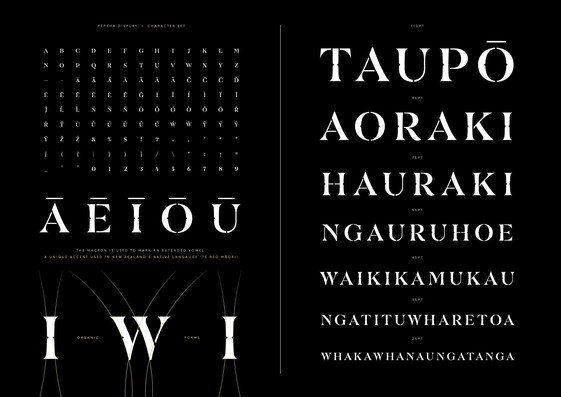
Jef: And it’s early days still. One thing I loved about it is seeing it then open up other sorts of conversations. What I’ve enjoyed from pepehā and the other projects we’ve been involved in is that it’s constant learning and that’s really awesome. Even when we’ve been working with different clients – and there is so much difference in the respective narratives – there are consistencies in stories and storytelling as well. Another treasure of Aotearoa is the place names. And that was another key reason why we put so much care and attention into the typography.
Anzac: That’s because the typography embodies the place names. It’s putting the Māori order of the landscape into the work. If you look at the nature of the metaphors, the type has got a fluidity of nature to it. The fluidity of a river, the stability of a mountain. You need to kind of close the gaps. If you look at the typeface, you’ll see notches scattered throughout, a form that you’ll see in the landscape and throughout marae, whare and churches, whatever your place of belonging might be. Then you take a step back it starts to take a kind of look of the bones. So, iwi is an extension of the word kōiwi – and kōiwi is just bones. That’s also another component of pepehā. So hapū is your place of birth but also, if a woman is pregnant, she’s hapū. And hapū is your place of birth. Where you belong. And your iwi is your tribe. And that’s where your bones belong. So that’s an extension of kōiwi. So, if you do start to take a deeper look at the typeface you might start to see those bone forms.
Jef: All of these things add depth to the design. We don’t expect people to come and look at the font, specifically. What you do tend to see are the names captured within that font. You get a sense of it being special. That’s there’s been care and attention paid to the typography and the design. And that adds to the momentum of people wanting to embrace it, get behind it, wear it on their T-shirt or hang it on their wall.

